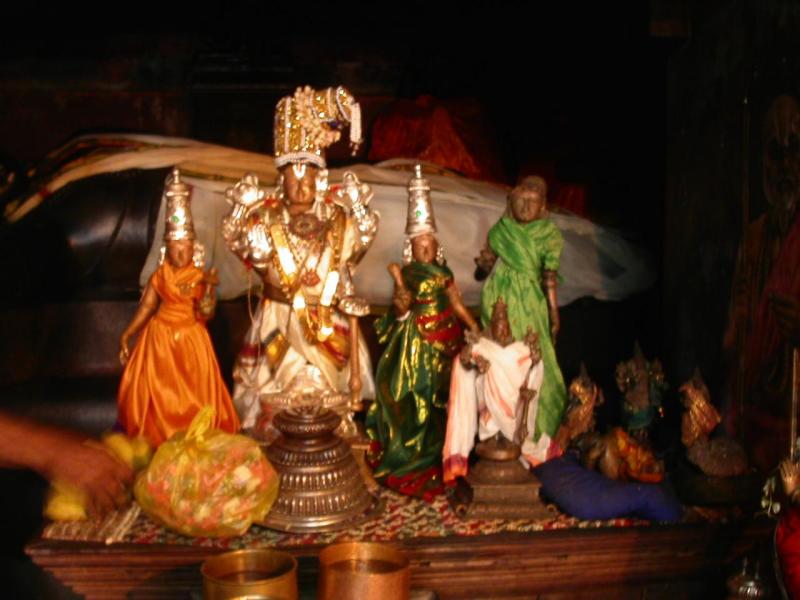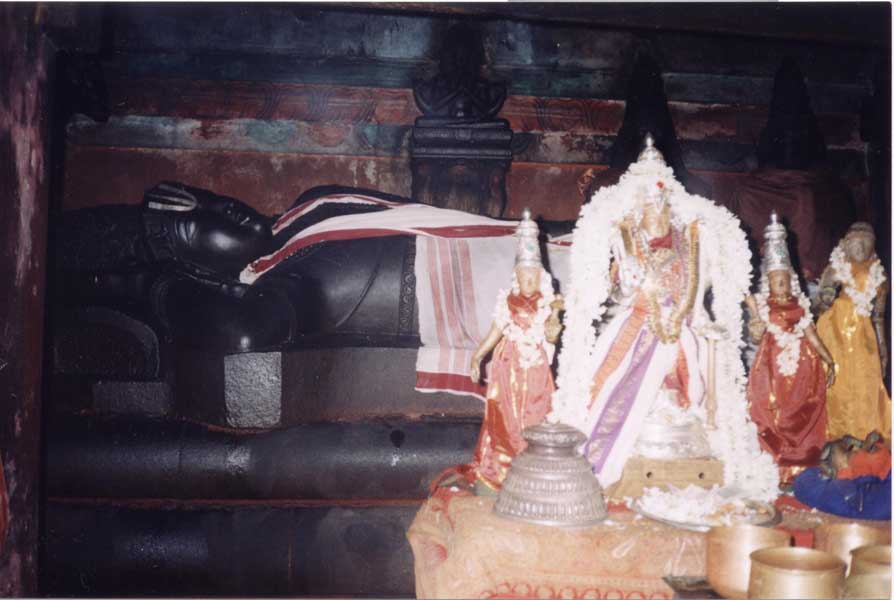Dwajasthambam

Utsavar
The Lord here is called Sri Aandalakkum Ayyan. Aandu [ruling] + alakkum [ measuring or governing]. He rules the Universe and also governs all His subjects and ensures their safe and comfortable living. He is keeping His right arm as head rest and als is keeping a measuring cylinder [ Tamil marakkal - மரக்கால்]. He is also keeping a writing tool [எழுத்தாணி - used to write on palm leaves]. He is said to keep accounts of all His devotees. At His feet are Sri Sridevi and Sri Bhoodevi. We can also see Kamadhenu at the feet. Sage Brihu and Agni are also present. As a unique feature the last among Alwars, Thirumangai Alwar also is seen in the garbagruha. Utsavar is Sri Ranganatha. We will now see the 11th sloka:
yad aksharam veda-vido vadanti
vishanti yad yatayo vita-ragah
yad icchanto brahmacaryam caranti
tat te padam sangrahena pravaksye
"Persons who are learned in the Vedas, who tell the indestructible nature, will be attained by cutting off desires. Desiring such perfection, one practices celibacy. I shall now briefly explain to you this process by which one may attain kaivalyam."
Sri Krishna tells about kaivalyam to Arjuna. In these three slokas Sri Krishna tells what should the kaivalyarti should meditate; what he is to remember at the time of death; and where he should spot his prana. Aiswaryarti was to spot the prana in between the eye brows. Likewise kaivalyarti is to spot the prana in the centre of head [உச்சந்தலை] and meditate on the Lord. That spot is called moorddhani. Kaivalyarti is the one who desires to enjoy his own atman; he has no desire for worldly life; wants to get rid off karma; does not want to suffer birth, death, old age; he has no desire to be in Vaikuntam either, in the company of other devotees. So, he does not want this world nor the Vaikuntam and wants to be in an isolated place. We have seen entities are three - chit, achit and Iswara. Very glaring examples of achit are what all we see. Our soul are Chit. Achit has no intelligence. Chit or soul has intelligence. Atman in its natural form is full of bliss; but the infinite accumulated papa/ punya acquired from various karmas performed in various births, bind the atman in a body and is not able to fully enjoy the natural bliss or happiness. It is wrong to think that the Lord makes us to commit sins or acquire punya. He has no desire for us to suffer. Body is required to expend the accumulated papa and punya. Why not allow them to continue? Why at all is it necessary to spend them? Otherwise we can never get out of this birth- death cycle. Exhausting these papa and punya will enable any atman to come out of this cycle. When all karma are spent, one attains mukti or freedom. Mukti can be of two types. One is to reach Vaikuntam and in the company of other devotees serve the Lord for ever. But kaivalyam is an inferior stage with no more births and consequent old age, hunger or thirst sufferings. He neither goes to Moksham but remains enjoying his own atman for ever. Such a person desiring to enjoy his own atman is called kaivalyarti. It is superior to the worldly life; but inferior to the life at Vaikuntam. So, this is not a stage we should ever aspire for. But there might be a few aspiring and for them the Lord tells the practices to be followed. Veda vido = those who have learned Vedas well, yad vadanthi = tell that, aksharam = indestructible, changeless and non-decaying. These qualities are attributable to both the Lord and our atman. But atman suffers, we may ask. Present heat in summer is torturing. But actually, these affect the body and as seen earlier, atman can not be dried nor wet nor burnt. By being resident of a body, the atman experiences these sufferings or pleasures. Without a body, atman does not undergo these sufferings or pleasures. To avoid a body, karma has to be exhausted. So kaivalyarti meditates on the Lord. He is Aksharam and so the atman also attains that state. In Brahadaranyopanishad, in Gargi prasnam, attributes of the Lord are explained. The Lord is neither big nor small; neither long nor short; neither black nor fair; etc. Vita raga = those who have cut off or removed [worldly] desires. Yata = with such efforts, yad vishanti = attain those [positions]. So kaivalyarti should renounce desires. Icchanti = desiring [ to get kaivalyam], brahmacharyam = celibacy, charanti = practicing. Brahmacharya means avoiding sexual activities. We should note that those aspiring to reach Vaikuntam need not follow brahmacharyam. They can continue in their normal activities. This strict code of conduct is necessary for kaivalyarti alone. Tat te padam = that high position to you, sangrahena = precisely, pravaksye = will be told [by Sri Krishna to Arjuna]. Kaivalyam level is also like the padam or position of the Lord; because both do not have rebirths and no bondage of karma, etc. Like Kamadhenu, He grants all , be he a kaivalyarti or aiswaryarti.

No comments:
Post a Comment